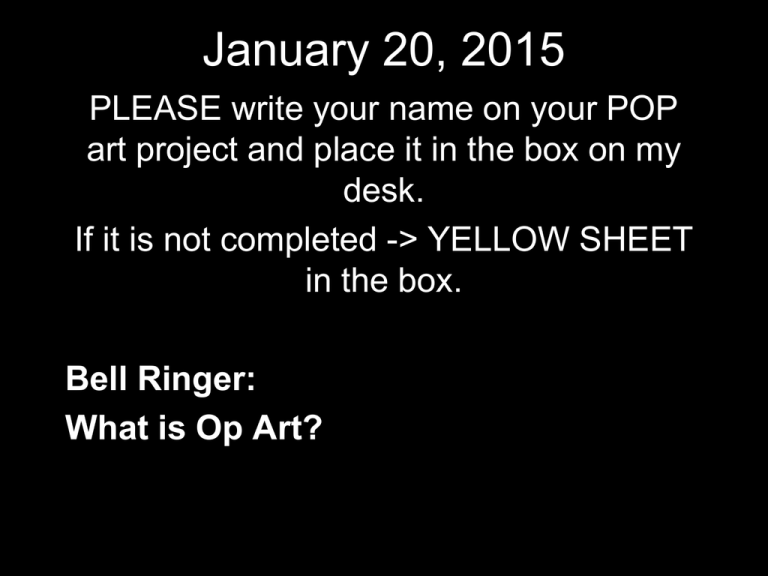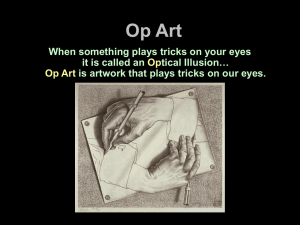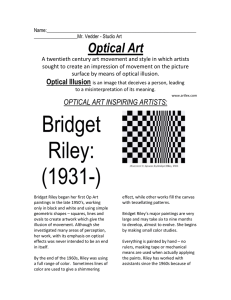Optical Art
advertisement

January 20, 2015 PLEASE write your name on your POP art project and place it in the box on my desk. If it is not completed -> YELLOW SHEET in the box. Bell Ringer: What is Op Art? January 21, 2015 What 3 artists are known for their contributions to Op Art? January 22, 2015 What Elements & Principles of Art are associated with Optical Art? January 23, 2015 What are 3 other art historical periods that are occurring at the same time as Optical Art? Optical Art Optical Art • The term Op Art refers to Optical Art. • Art that plays tricks on our eyes. • It was first called “kinetic art” – art which actually moves. Terms We Need to Know Elements • Space: – There are two types of space; positive (filled-in) and negative (empty) – Space deals with how open some areas are and how filled-in others are Terms We Need to Know Principles • Movement – Can be real (like in mobiles) or created – How the piece is arranged to make our eyes move • Do our eyes move quickly? Slowly? Visual Movement Actual Movement Terms We Need to Know Principles • Contrast – The difference between different elements in a piece of art – The difference in how light and dark the colors or values in a piece are • Black and white is the greatest contrast you can have in terms of value Flashback to the 1960s • The world was in a state of flux - everything was changing • President Kennedy had just been assassinated • The Civil Rights movement was taking place • The Beatles were forever changing the sound of music • The “ideal” 1950s were fading away and the radical change of the 1960s and youth culture were taking place The 1960s in Art • Art during the 1960s was no different. • Artists had started experimenting with abstract art - art that does not show objects as they appear in real life Jackson Pollock was throwing paint around to show movement. Abstract Expressionism Jackson Pollock, Number 1, 1950 (Lavender Mist), 1950, National Gallery of Art, Washington DC Andy Warhol was creating multiples of pop culture images like Marilyn Monroe. Pop Art Roy Lichtenstein was painting comic book pages. Pop Art And Mark Rothko was trying to capture emotions with fields of color. Color Field Painting Mark Rothko, Four Darks in Red, Oil on Canvas, 1958, 102 x 116” Whitney Museum of American Art Art Had Gone Mad Gone were the days of painting a portrait or a vase of flowers. Art had to be more thoughtful, more academic. The Optical Artists didn’t want to be any different. They based a whole movement around how we see. Victor Vasarely (vah-sah-ray-lee) • Considered the Father of Op Art. • French artist who explored visual illusions, and combined geometric shapes with color and value to result in optical illusions. Victor Vasarely, Vega 200, 1968, Oil on Canvas, 200 x 200 cm, Foundation Vasarely Bridget Riley • Concerned of the most effective Op Art Illusionists. • British artist concerned with creating movement in black and white and disorientation Bridget Riley Movement in Squares, 1961 Tempera on Board, 48 x 48 “, Private Collection. M.C. Escher • Dutch graphic artist who explored mathematics. • He featured impossible constructions, explorations of infinity, architecture and tessellations. MC Escher, Sky and Water I, 1938, Woodcut, 17.1 x 17.3” MC Escher Gallery Tessellation: Similar to a motif; a shape that is repeated in a work of art that fills the entire space and leaves no empty (negative) spaces nor overlapping parts. Let’s try a few… #1: Which center circle is bigger? #2: What do you notice about the lines that stretch across the image? #3: Is this a spiral? #4: How many faces do you see? Color Op When you stare at a color for a long time, then you stare into an empty space… you can sometimes see the opposite of that color!! Color Op When you stare at a color for a long time, then you stare into an empty space… you can sometimes see the opposite of that color!! #5: Stare at the center for 15 seconds and then on a white surface– what do you see? #6: How many black dots are there? #6: What color are the dots? #7: How many triangles are there? #8: How do the wheels move? #9: Do you look through the cylinder from the right, or from the left? #10: The Ames Room Can one girl really be that much bigger than the other? Extra Credit: Click on the link below and open it. Read about the Ames Room. Type a ONE PAGE paper on the Ames Room •Double-spaced •Correct grammar & spelling •12 point font – Times New Roman. DUE: FRIDAY, MARCH 21, 2014 Further Reading: http://psylux.psych.tudresden.de/i1/kaw/diverses%20Material/www.illusionwor ks.com/html/ames_room.html Impossible Figures Objects that can be represented in twodimensional pictures but cannot exist in three-dimensional space You will learn and practice three main types of optical illusions in your sketchbook: - Rail Road Tracks - Circus Tent - Checkerboard Once you have completed these exercises you will use your handout to come up with 6 more sketches of your own.





